 W
WAmpullaria bicarinata is an extinct species of freshwater snail with an operculum, an aquatic gastropod mollusk in the family Ampullariidae.
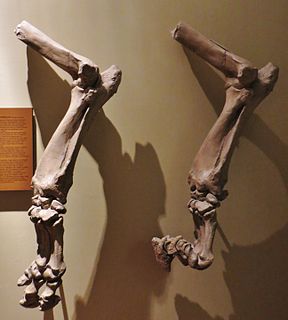 W
WAncylotherium is an extinct genus of the family Chalicotheriidae, subfamily Schizotheriinae, endemic to Europe, Asia, and Africa during the Late Miocene-Early Pleistocene, existing for approximately 7.2 million years .
 W
WAndrogynoceras is an extinct genus of cephalopod belonging to the Ammonite subclass. The Green Ammonite Beds of the Dorset Coast are named after Androgynoceras lataecosta which has chambers filled with green calcite.
 W
WThe Balkan snow vole, Dinaromys bogdanovi, also known as Martino's snow vole is the only member of the genus Dinaromys. Eight subspecies of this vole have been recognized from southern parts of Europe. The genus name means "Dinaric mouse", referring to the Dinaric Alps. The Balkan snow vole is a living fossil, the only living genus in the tribe Pliomyini and might arguably better be placed in Pliomys, a genus established for its fossil relatives even before the Balkan snow vole was scientifically described.
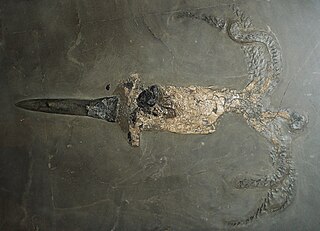 W
WBelemnitida is an extinct order of squid-like cephalopods that existed from the Late Triassic to Late Cretaceous. Unlike squid, belemnites had an internal skeleton that made up the cone. The parts are, from the arms-most to the tip: the tongue-shaped pro-ostracum, the conical phragmocone, and the pointy guard. The calcitic guard is the most common belemnite remain. Belemnites, in life, are thought to have had 10 hooked arms and a pair of fins on the guard. The chitinous hooks were usually no bigger than 5 mm (0.20 in), though a belemnite could have had between 100 and 800 hooks in total, using them to stab and hold onto prey.
 W
WThe cave bear was a species of bear that lived in Europe and Asia during the Pleistocene and became extinct about 24,000 years ago during the Last Glacial Maximum.
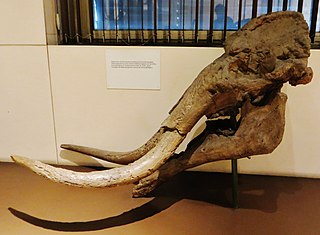 W
WChoerolophodontidae is an extinct family of large herbivorous mammals that were closely related to elephants. Two genera are known, Afrochoerodon and Choerolophodon.
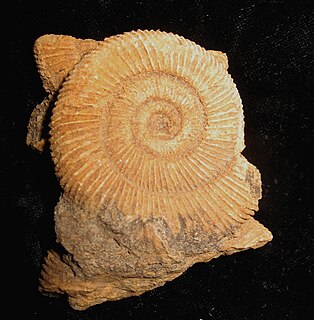 W
WDactylioceras was a widespread genus of ammonites from the Lower Jurassic period, approximately 180 million years ago (mya).
 W
WElopteryx is a genus of, perhaps troodontid, maniraptoran theropod dinosaur based on fragmentary fossils found in late Cretaceous Period rocks of Romania. The single species, Elopteryx nopcsai, is known only from very incomplete material, and therefore is considered a nomen dubium by most paleontologists.
 W
WExogyra is an extinct genus of fossil marine oysters in the family Gryphaeidae, the foam oysters or honeycomb oysters. These bivalves grew cemented by the more cupped left valve. The right valve is flatter, and the beak is curved to one side. Exogyra lived on solid substrates in warm seas during the Jurassic and Cretaceous periods.
 W
WGraecopithecus is a hominin originally identified by a single mandible found in Greece in 1944. Since then, analysis of tooth specimens, dated to 7.2 million years ago, has led to suggestions that Graecopithecus may have been the oldest direct ancestor of humans excluding the chimpanzee lineage, or alternatively the last common ancestor of both humans and chimpanzees, though other scientists are skeptical of these claims. The creature was nicknamed 'El Graeco' by scientists.
 W
WGryphaea, common name devil's toenails, is a genus of extinct oysters, marine bivalve mollusks in the family Gryphaeidae.
 W
WHeteraster is an extinct genus of sea urchins belonging to the family Toxasteridae.
 W
WHindeodus is an extinct genus of conodonts in the family Anchignathodontidae. The generic name Hindeodus is a tribute to George Jennings Hinde, a British geologist and paleontologist from the 1800s and early 1900s. The suffix -odus typically describe’s the animal’s teeth, essentially making Hindeodus mean Hinde-teeth.
 W
WHippurites atheniensis is an extinct species of fossil saltwater clam, a marine bivalve mollusk in the family Hippuritidae. These fossils occur in the Late Cretaceous deposits of Greece, Serbia, Dalmatia, Istria, Bosnia and Herzegovina, Slovenia, Bulgaria and Italy.
 W
WInoceramus is an extinct genus of fossil marine pteriomorphian bivalves that superficially resembled the related winged pearly oysters of the extant genus Pteria. They lived from the Early Jurassic to latest Cretaceous.
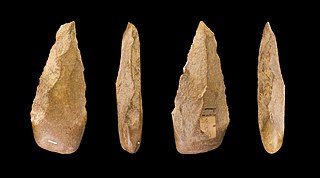 W
WThe Lower Paleolithic is the earliest subdivision of the Paleolithic or Old Stone Age. It spans the time from around 3 million years ago when the first evidence for stone tool production and use by hominins appears in the current archaeological record, until around 300,000 years ago, spanning the Oldowan and Acheulean lithics industries.
 W
WMacroscaphites is an extinct cephalopod genus included in the Ammonoidea that lived during the Barremian and Aptian stages of the Early Cretaceous. Its fossils have been found throughout most of Europe and North Africa.
 W
WMegalodon is an extinct genus of bivalve molluscs that reportedly lived from the Devonian to the Jurassic period. It is not clear, however, that all the fossils assigned to Megalodon from that span of time really belong in the same genus. Jurassic relatives of Megalodon such as Pachyrisma grande were closely related to the rudists.
 W
WMegatrigoniidae is an extinct family of fossil saltwater clams, marine bivalve molluscs in the subclass Palaeoheterodonta. This family of bivalves is known in the fossil record from the Jurassic period, Tithonian age, to the Cretaceous period, Maastrichtian age. Species in this family were facultatively mobile infaunal suspension feeders.
 W
WNicaisolopha is a genus of true oysters.
 W
WOncodella is an extinct genus of Late Triassic conodont. The genus was given the type species Oncodella idiodentica by Mosher (1968), on the basis of fossils from the Late Triassic of Austria. However, Mosher (1969) later revised the species name to Oncodella paucidentata, since identical fossils from the same area were previously given the name Hindeodella paucidentata by Mostler (1967).
 W
WParaceratites is an extinct genus of ammonite cephalopods in the family Ceratitidae.
 W
WPleuroceras is a genus of ammonite from the lower Jurassic, upper Pliensbachian.
 W
WPleuroceras spinatum is a species of ammonite from the lower Jurassic, upper Pliensbachian period. Species of this genus were fast-moving nektonic carnivore.
 W
WPterorigonia is an extinct genus of saltwater clams, marine bivalve molluscs in the family Megatrigoniidae. This genus is known in the fossil record from the Jurassic period Tithonian age to the Cretaceous period Maastrichtian age. Species in this genus were facultatively mobile infaunal suspension feeders. The type species of the genus is Pterotrigonia cristata.
 W
WPuzosia is a genus of desmoceratid ammonites, and the type genus for the Puzosiinae, which lived during the middle part of the Cretaceous, from early Aptian to Maastrichtian. Sepkoski defines the range from Albian to Santonian. The generic name comes from the Serbian words "Puž" (snail) and "oce/ose" (axis), gaining its name from the shell's snail-like appearance.
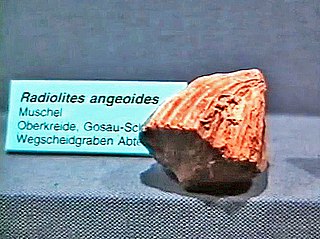 W
WRadiolites is a genus of rudists in the family Radiolitidae.
 W
WRequienia is an extinct genus of fossil saltwater clam, a marine bivalve molluscs in the order Hippuritida, family Requieniidae. These rudists lived in the Cretaceous period, from the Valanginian age (136.4–140.2) to the Campanian age. They were stationary intermediate-level suspension feeders.
 W
WThe steppe mammoth is an extinct species of Elephantidae that ranged over most of northern Eurasia during the late Early and Middle Pleistocene, approximately 1.7 million-200,000 years ago. It evolved in Siberia during the Early Pleistocene from Mammuthus meridionalis. It was the first stage in the evolution of the steppe and tundra elephants and the ancestor of the woolly mammoth and Columbian mammoth of the later Pleistocene. Populations of steppe mammoth may have persisted in northern China and Mongolia as recently as 33,000 years ago.
 W
WThecodontosaurus is a genus of herbivorous basal sauropodomorph dinosaur that lived during the late Triassic period.
 W
WTragophylloceras is an extinct genus of cephalopod belonging to the Ammonite subclass.
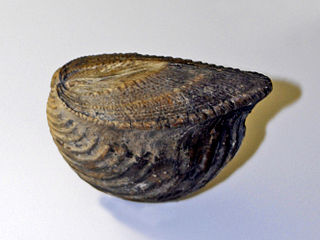 W
WTrigonia is an extinct genus of saltwater clams, fossil marine bivalve mollusk in the family Trigoniidae. The fossil range of the genus spans the Paleozoic, Mesozoic and Paleocene of the Cenozoic, from 298 to 56 Ma.
 W
WValeriana is a genus of flowering plants in the family Caprifoliaceae, members of which may by commonly known as valerians. It contains many species, including the garden valerian, Valeriana officinalis. Some species are native to Europe, others to North America and South America.
 W
WZamites is a genus of fossil tree known from the Mesozoic of North America, Europe and India through the Eocene of North America. It is a form taxon for leaves that resemble the extant cycad Zamia. The fronds are linear or lanceolate in shape, and pinnately compound, with pinnae with parallel veins and smooth margins, and symmetrical and constricted at the base where they are attached obliquely to the upper surface of the rachis. It has been interpreted as a cycad in the family Cycadaceae or a Bennettitalean plant.